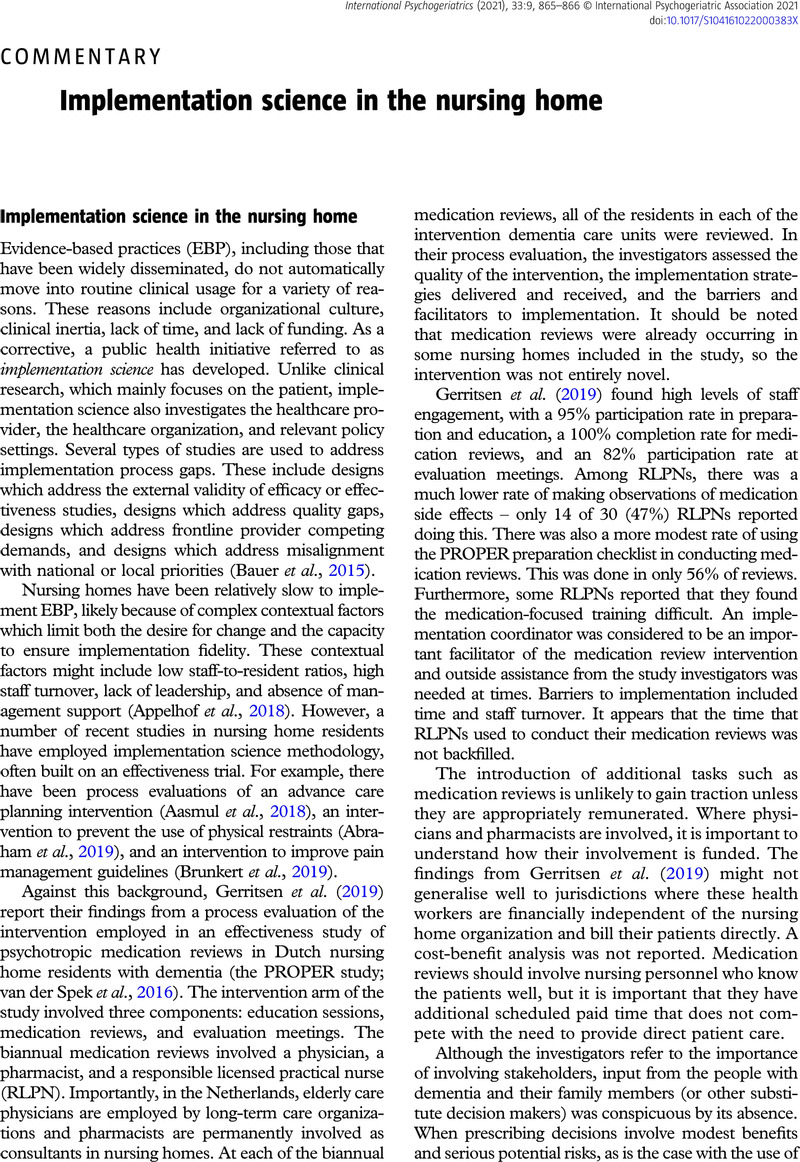No CrossRef data available.
Article contents
Implementation science in the nursing home
Published online by Cambridge University Press: 05 October 2021
Abstract
An abstract is not available for this content so a preview has been provided. Please use the Get access link above for information on how to access this content.

- Type
- Commentary
- Information
- International Psychogeriatrics , Volume 33 , Special Issue 9: Issue Theme: Implementation Science II , September 2021 , pp. 865 - 866
- Copyright
- © International Psychogeriatric Association 2021
References
Aasmul, I., Husebo, B. S., Sampson, E. L. and Flo, E. (2018) Description of an advance care planning intervention in nursing homes: outcomes of the process evaluation. BMC Geriatrics, 18, 26.CrossRefGoogle ScholarPubMed
Abraham, J. etal. (2019) Implementation of a multicomponent intervention to prevent physical restraints in nursing homes (IMPRINT): a pragmatic cluster randomized controlled trial. International Journal of Nursing Studies, 96, 27–34.CrossRefGoogle ScholarPubMed
Appelhof, B. etal. (2018). Process evaluation of an intervention for the management of neuropsychiatric symptoms in young-onset dementia. The Journal of the American Medical Directors Association, 19, 663–671.CrossRefGoogle ScholarPubMed
Ballard, C. etal. (2008). A randomised, blinded, placebo-controlled trial in dementia patients continuing to take or stopping neuroleptics (the DART-AD trial). PLoS Medicine, 5, e76.CrossRefGoogle Scholar
Bauer, M.S., Damschroder, L., Hagedorn, H., Smith, J. and Kilbourne, A. M. (2015). An introduction to implementation science for the non-specialist. BMC Psychology, 3, 32.CrossRefGoogle ScholarPubMed
Brunkert, T., Simon, M., Ruppen, W. and Zúñiga, F. (2019). Pain management in nursing home residents: findings from a pilot effectiveness-implementation study. Journal of the American Geriatrics Society, 67, 2574–2580.CrossRefGoogle ScholarPubMed
Devanand, D. P. etal. (2012). Relapse risk after discontinuation of Risperidone in Alzheimer’s disease. New England Journal of Medicine, 367, 1497–1507.CrossRefGoogle ScholarPubMed
Gerritsen, D. L. etal. (2019). Implementing a multidisciplinary psychotropic medication review among nursing home residents with dementia: a process evaluation. International Psychogeriatrics, 33, 933–945.CrossRefGoogle Scholar
Ma, H. etal. (2014). The efficacy and safety of atypical antipsychotics for the treatment of dementia: a meta-analysis of randomized, placebo-controlled trials. Journal of Alzheimer’s Disease, 42, 915–937.CrossRefGoogle Scholar
Scales, K., Zimmerman, S. and Miller, S. J. (2018). Evidence-based nonpharmacological practices to address behavioural and psychological symptoms of dementia. Gerontologist, 58, S88–S102.CrossRefGoogle Scholar
Van der Spek, K. etal. (2016). Only 10% of the psychotropic drug use for neuropsychiatric symptoms in patients with dementia is fully appropriate. the PROPER-I study. International Psychogeriatrics, 28, 1589–1595.CrossRefGoogle ScholarPubMed




